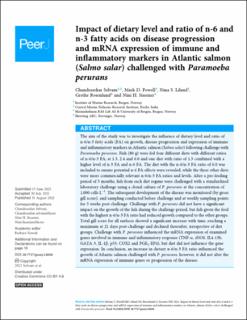| dc.description.abstract | The aim of the study was to investigate the influence of dietary level and ratio of n-6/n-3 fatty acids (FA) on growth, disease progression and expression of immune and inflammatory markers in Atlantic salmon (Salmo salar) following challenge with Paramoeba perurans. Fish (80 g) were fed four different diets with different ratios of n-6/n-3 FA; at 1.3, 2.4 and 6.0 and one diet with ratio of 1.3 combined with a higher level of n-3 FA and n-6 FA. The diet with the n-6/n-3 FA ratio of 6.0 was included to ensure potential n-6 FA effects were revealed, while the three other diets were more commercially relevant n-6/n-3 FA ratios and levels. After a pre-feeding period of 3 months, fish from each diet regime were challenged with a standardized laboratory challenge using a clonal culture of P. perurans at the concentration of 1,000 cells L−1. The subsequent development of the disease was monitored (by gross gill score), and sampling conducted before challenge and at weekly sampling points for 5 weeks post-challenge. Challenge with P. perurans did not have a significant impact on the growth of the fish during the challenge period, but fish given the feed with the highest n-6/n-3 FA ratio had reduced growth compared to the other groups. Total gill score for all surfaces showed a significant increase with time, reaching a maximum at 21 days post-challenge and declined thereafter, irrespective of diet groups. Challenge with P. perurans influenced the mRNA expression of examined genes involved in immune and inflammatory response (TNF-α, iNOS, IL4-13b, GATA-3, IL-1β, p53, COX2 and PGE2-EP4), but diet did not influence the gene expression. In conclusion, an increase in dietary n-6/n-3 FA ratio influenced the growth of Atlantic salmon challenged with P. perurans; however, it did not alter the mRNA expression of immune genes or progression of the disease. | en_US |
